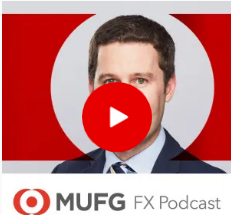November has been a bad month for the USD
USD: On track for largest monthly decline since November of last year
The US dollar has continued to soften at the start of this week with weakness most evident against the yen overnight. It leaves on the dollar index on track to record its first monthly decline since July, and it is on track to be the largest in percentage terms since November of last year when it declined sharply by -5.0%. The main similarity to last year was that the US dollar sell-off followed the peaking out of US yields in October. US yields then corrected lower before consolidating at lower levels through the first half of this year. On this occasion US yields have again peaked in October and have since corrected lower through November with the 10-year US Treasury yield currently standing just over 50bps below the peak from 23rd October at 5.02%. Recent comments for Fed officials and the release of the softer US CPI and nonfarm payrolls reports for October have given market participants more confidence that the Fed’s rate hike cycle ended back in July. It has triggered a powerful relief rally for risk assets. The S&P500 index has almost reversed all of the sell-off that took place between August and October when it declined by almost 11.0%. The main beneficiaries from the marked improvement in investor risk sentiment amongst G10 FX have been the high beta currencies of the Swedish krona (+6.9% vs. USD MTD), Norwegian krone (+4.5%), New Zealand dollar (+4.3%) and Australia dollar (+4.0%). It leaves the US dollar vulnerable to further weakness in the week ahead if investor risk sentiment continues to improve. It appears unlikely that there will be significant shift in expectations for Fed policy that could trigger a reversal of US dollar weakness. The main economic data release in the week ahead will be the latest PCE deflator report (Thurs) for October which is expected to provide further evidence of slower inflation following on from the October CPI report. Fed Chair Powell is also scheduled to speak towards the end of this week on Friday.
It has not all been bad news for the US dollar. Investor optimism over the potential for a reduction in geopolitical tensions between Taiwan and China after the Taiwan election at the start of next year suffered a blow at the end of last week when the two main opposition parties failed to agree on a unity presidential ticket. The talks between the KMT and TPP parties after they were unable to agree on who should head their unity ticket. In the end KMT candidate Hou Yu-ih and TPP candidate Ko Wen-je both registered as separate candidates for next year’s election. The development increases the likelihood that the ruling DPP party candidate and sitting Vice President Lai Ching-te will be elected Taiwan’s next president on 13th January. An unfavourable development for geopolitical tensions in the region. This month’s rebound for the Taiwan dollar and Asian currencies more broadly has lost upward momentum over the past week. However, the latest twist in the drama from the weekend has been the release of a poll showing opposition TPP candidate Ko Wen-je has an approval rating of 31.9% moving ahead of DPP candidate Lai Ching-te. It is the first time that he’s beat Lai in a survey by the Taiwanese Public Opinion Foundation. Other polls though show Ko running third.
USD/TWD VS. ASIA FX PERFORMANCE

Source: Bloomberg, Macrobond & MUFG GMR
GBP: BoE rate cut expectations have been pared back supporting GBP
The GBP has strengthened modesty over the past week against both the EUR and USD. It has resulted in EUR/GBP falling back below the 0.8700-level after hitting a high of 0.8768 on 20th November, while cable has risen back above 1.2600 as it moves further above the 200-day moving average that comes in at around 1.2455. The GBP is continuing to benefit from the improvement in global investor risk sentiment this month which has helped it to outperform against other major currencies (EUR, CHF, JPY & USD) in November. After bottoming in late October, MSCI’s ACWI global equity index has staged a strong rebound (~10%) and moved back closer to the calendar year highs set back in late July. The recent less hawkish change in guidance from major central banks and slowing inflation have made market participants more confident that rate hike cycles are at an end helping to diminish hard landing fears.
At the same time, the GBP has derived more support over the past week from the scaling back of BoE rate cut expectations. The implied yield on the December 2024 SONIA futures contract has risen by around 20bps over the past week to 4.62%. It leaves the UK rate market pricing in around 57bps of BoE cuts by the end of next year, and the expected timing of the first rate cut has been delayed until the September MPC meeting. There have been three main triggers for the hawkish repricing of the UK rate curve over the past week: i) stronger pushback from BoE officials against market expectations for earlier rate cuts, ii) the fiscal giveaways in the UK government’s autumn statement alongside a strong indication that further tax cuts are likely to be delivered in next year’s budget, and iii) the unexpected improvement in UK business confidence in November that has helped to ease concerns over a further loss of cyclical momentum for the UK economy heading into year end.
The developments are making market participants relatively cautious over pricing in rate cuts from the BoE compared to the ECB and Fed, who are both expected to begin cutting rates sooner (from June) and by more next year (around 84bps of cuts by the end of next year). While inflation fell more sharply in the UK in October, it remains higher than in the euro-zone and US, and stronger wage growth is contributing to concerns that inflation will prove more persistent in the UK. The developments should help to provide more support for the GBP in the near-term in so far as short-term yield spreads are moving back in favour of the UK. However, we remain sceptical that the recent upward adjustment for UK rates will be sustained. We expect weak growth and slowing inflation in the coming quarters to encourage market participants to price back in more BoE rate cuts. The OBR’s updated growth forecasts revealed that they expect growth to remain weak after incorporating the impact from the new fiscal measures. In these circumstances, the GBP could strengthen further in the near-term against EUR and USD, but the gains are built on shaky foundations. Please see our latest FX Weekly for more details (click here).
IMPROVING RISK SENTIMENT HELPS TO LIFT GBP

Source: Bloomberg, Macrobond & MUFG GMR
xKEY RELEASES AND EVENTS
|
Country |
GMT |
Indicator/Event |
Period |
Consensus |
Previous |
Mkt Moving |
|
SZ |
09:00 |
Total Sight Deposits CHF |
Nov-24 |
-- |
476.9b |
! |
|
UK |
11:00 |
CBI Retailing Reported Sales |
Nov |
-- |
- 36.0 |
!! |
|
EC |
14:00 |
ECB's Lagarde Speaks in EU Parliament |
!!! |
|||
|
US |
15:00 |
New Home Sales |
Oct |
723k |
759k |
!! |
|
US |
15:30 |
Dallas Fed Manf. Activity |
Nov |
- 16.0 |
-19.2 |
!! |
Source: Bloomberg



